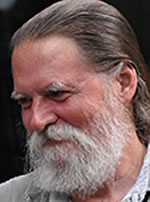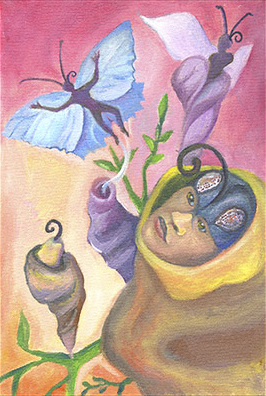by guest blogger William Douglas Horden, author and spiritual teacher
Fear-based thoughts are part of our DNA passed down through the generations—our species succeeded in part because we were constantly vigilant for any potential threat to our welfare. While this worked well to keep us alive, constant vigilance produces worry and stress as our minds continually scan the environment for things to be concerned about.
And because our sense of welfare expands with increased understanding of the workings of the world around us, the kinds of things we perceive as potential threats also expands beyond the merely physical: Am I good enough? Am I worthy? Am I lovable? Can I trust? What is the future bringing? When we latch on to one or more such thoughts, and relive them in our minds, we form habits of thought and emotion. This “habit-mind” can pull us out of the present moment and into worrying about the future or regretting the past.
Every spiritual tradition I am aware of agrees that it is essential for us to take time out from our daily routines and spend some time in quiet prayer, contemplation, meditation, or other form of spiritual exercise. Regardless of the spiritual tradition, the goal is the same: to establish our awareness more firmly in the present moment so that we can experience our soul more consciously. Or, to put it another way, to quiet the habit-mind and concentrate fully on the moment at hand.
I would like to recommend a few exercises that many of my students have found useful in reaching this goal.
1. THE ENOUGH! EXERCISE
Relax with eyes closed. Instead of following your normal thoughts, however, silently repeat the word Enough! as a way to block habit-thoughts before they get started. If self-defeating thoughts arise, silently repeat the word Enough! in an authoritative manner, as if you were cutting off a trivial and insulting conversation before it could even get started. At first, it’s necessary to practice this exercise nearly all the time, but as it replaces the old habit of self-defeating thoughts this new habit of inner dignity and self-possession become the rule—at which point, you begin hearing the word Enough differently, for it has subtly taken on the connotation of Having Enough and Being Enough.
2. THE KEEP MOVING EXERCISE
Visualize yourself as a ball carried along on a swiftly-moving stream. As you sense yourself flowing along on the surface of the rushing water, repeat to yourself the phrase, Keep Moving. As any particular thoughts, emotions, or memories arise, visualize each as a rock or branch sticking out of the water that you bump into and then flow around. With some practice, visualize yourself flowing around them before even reaching them. With more practice, hold on to this sensation and carry it around with you in your everyday activities, keeping your attention moving with the present moment. Whenever old attitudes threaten to capture your attention and hold it back, return to the sense of it being an obstacle in the stream that you are flowing around as you repeat the phrase, Keep Moving.
3. THE HEART-SUN EXERCISE
Sit quietly with eyes closed, silently repeating to yourself, My heart is another sun. Concentrate your attention on the center of your chest, visualizing a grapefruit-sized sun there radiating light and warmth out into the world. Allow the visualization to sink into your emotions, so that the heart-sun within your chest emits unconditional loving-kindness and goodwill out into the world. Allow the emotional feelings to sink deeper yet into your material body, producing physical sensations of a corporeal sun from which emanate emotional healing rays of golden light. Carry the exercise out during all your daily activities until it becomes second nature. Keep in mind that no shadow can ever fall upon the sun as you silently repeat the phrase, My heart is another sun.
4. THE ONE BREATH EXERCISE
Sit quietly with eyes closed, breathing slowly from the abdomen. Visualize yourself as an open window in an ancient stone wall that runs across a vast plateau ringed by mountains and crowned by clouds. The wind blows this way and then that way, constantly shifting, rushing first from one side of the ancient wall and then from the other. As the wind pours through you, first this way and then the other, silently repeat the phrase, One. After practicing this for a while, visualize the wind passing through you in one direction with each inhale and then shifting to pass through you in the opposite direction with each exhale. With each inhale, silently repeat the phrase, One. With each exhale, silently repeat the phrase, One.
5. THE WELL OF HAPPINESS EXERCISE
Sit quietly with eyes closed and visualize an upwelling of joy, a rejoicing in the perfection of all creation, surging out of you as you silently repeat the phrase, I am a well of happiness, overflowing into the lives of others. View all around you as perfect. Allow the emotional logic to sink in: a well of happiness is not changed by happy or sad things around it—it changes things around it by nurturing their deepest essence at that point where perfection recognizes perfection. The important thing here is to feel the emotion of joy upwelling in you and flowing out toward everything all at once, silently repeating the phrase, I am a well of happiness, overflowing into the lives of others.
The goal of these exercises is real freedom, spontaneity, and bliss. It is the freedom to think, feel, and act according to our best intentions, without being compelled by any force within or without. It is the spontaneity to respond to everything we encounter without preconception, uneasiness, or artificiality. And it is the bliss that comes when we clearly perceive the miracle of being alive.
The path of the cocoon does not lead to the cocoon—it leads to the path of the butterfly. For the butterfly, the blissful life is found flitting from one perfect blossom to the next, consuming only the nectar produced by perfect beauty and, in so doing, propagating the next generation of perfect beauty.
For us, the blissful life is no different.
 William Douglas Horden is spiritual teacher who has spent the last 40 years researching the religious traditions of the world. Trained in the Chinese classic text I Ching by Master Khigh Alx Dhiegh, he has a uniquely modern approach to the ancient arts. His book, The Toltec I Ching: 64 Keys To Inspired Action In The New World, recasts the ancient Oracle of China in the symbology of the Native Americans of Mesoamerica. Two companion volumes, The Five Emanations, and The Spiritual Basis of Good Fortune, explore how to carry the practices forward in the modern world. williamdouglashorden.com
William Douglas Horden is spiritual teacher who has spent the last 40 years researching the religious traditions of the world. Trained in the Chinese classic text I Ching by Master Khigh Alx Dhiegh, he has a uniquely modern approach to the ancient arts. His book, The Toltec I Ching: 64 Keys To Inspired Action In The New World, recasts the ancient Oracle of China in the symbology of the Native Americans of Mesoamerica. Two companion volumes, The Five Emanations, and The Spiritual Basis of Good Fortune, explore how to carry the practices forward in the modern world. williamdouglashorden.com
Top photo by William Douglas Horden







Just reading through the article gave me a good sense of being. I look forward to doing the exercises.
Idid each one of the five and they are just down my spiritual consciousness. Thank you for being so alive and making others living in the “Now”.